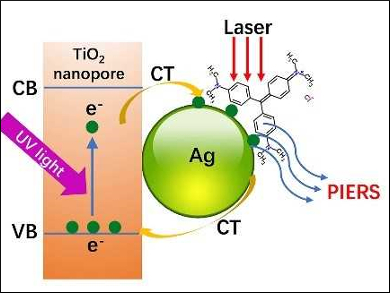Surface-enhanced Raman spectroscopy (SERS) allows Raman scattering by molecules adsorbed on rough metal surfaces or by nanostructures. It allow to detect single molecules. Photo-induced enhanced Raman spectroscopy (PIERS) is based on light-induced charge transfer (CT) from a semiconductor to a plasmonic metal surface upon UV irradiation (pictured). The method can achieve significant Raman enhancement, outperforming the commonly used SERS. The integration of PIERS and portable Raman instruments could provide a portable analytical platform for the trace detection of toxic organic compounds.
Maofeng Zhang, Hefei University of Technology, China, and colleagues have fabricated a hybrid semiconductor/metal nanostructure with PIERS properties. The material is composed of ordered TiO2 nanopore arrays and uniformly deposited Ag nanoparticles. The TiO2 nanopore arrays were prepared by a one‐step anodization of titanium foil. Ag nanoparticles were loaded on the TiO2 nanopore arrays by a simple silver mirror reaction.
The prepared hybrid material achieves an eight-fold higher Raman enhancement than commonly used SERS. Using a portable Raman device, the PIERS substrate can detect a variety of organic substances, such as antiseptics (crystal violet) and pesticides (Carbaryl, Phoxim, and Thiram) with a low limit of detection. The structure is robust enough for multiple reuse cycles. According to the researchers these findings can be used to readily detect the residues of toxic organics in the field with a portable device.
- Three-dimensional TiO2-Ag nanopore arrays for powerful photo-induced enhanced Raman spectroscopy (PIERS) and excellent detection versatility of toxic organics,
Maofeng Zhang, Tun Chen, Yongkai Liu, Jiping Zhu, Jiaqin Liu, Yucheng Wu,
ChemNanoMat 2018.
https://doi.org/10.1002/cnma.201800389



